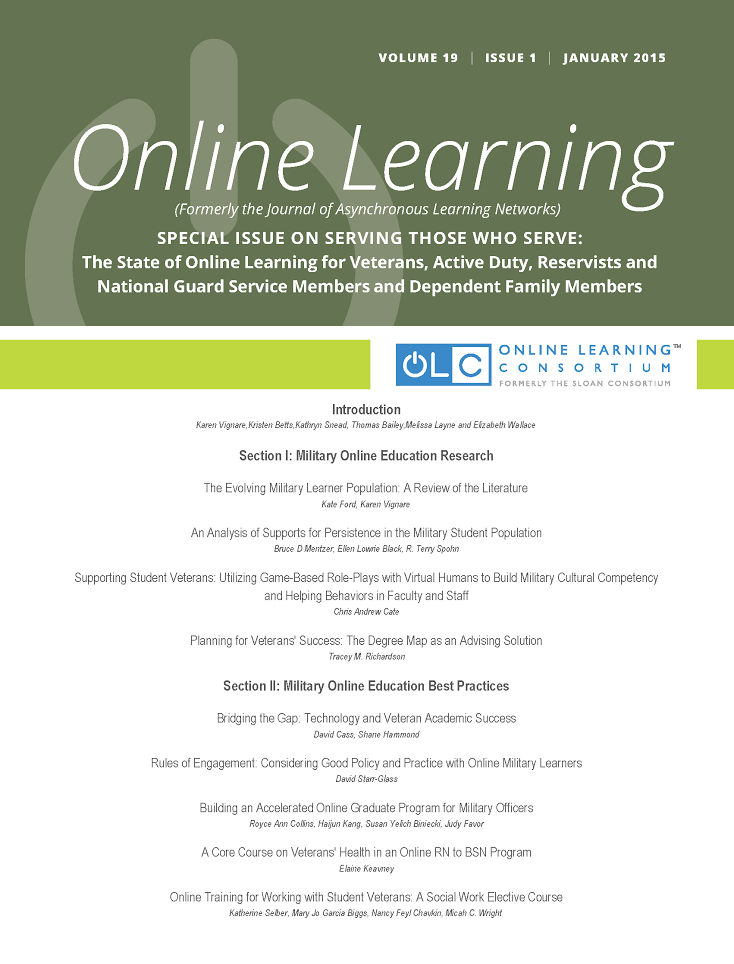Bridging the Gap: Technology and Veteran Academic Success
DOI:
https://doi.org/10.24059/olj.v19i1.517Keywords:
Technology, discussion, Uvize, mentoringAbstract
This paper presents two unique yet confluent perspectives regarding the use of technology to support student veterans in college, and is meant to ignite discussion of the blending of high impact practices with technology to promote their academic success. The authors highlight the historical trends of student veterans in the academy and discuss the barriers to success for this unique population of students. Uvize, an online mentoring and advising platform for student veterans, is introduced with an overview of the creation of the program and preliminary results from three forward thinking institutions. This article further defines why student veterans are a special student population on our campuses and require unique services to support their overall academic success. Theoretical and pragmatic technology based solutions for student veteran successes are presented.References
References
Ackerman, R., DiRamio, D., & Mitchell, R. L. (2008). From combat to campus: Voices of
student-veterans. NASPA Journal, 45(1), 73-102. Retrieved from
http://www.naspa.org/pubs/index.cfm
Ackerman, R., & DiRamio, D. (2009). Transitions: Combat veterans as college students. New
Directions for Student Services, 126, 5-14.
Brown, E. (2009). Colleges try to ease veterans’ move from combat to classroom. The
Washington Post. Retrieved from
http://www.washingtonpost.com/wp-dyn/content/article/2009/09/17/AR2009091704680
Brown, P. A., & Gross, C. (2011). Serving those who have served: Managing veteran and
military best practices. The Journal of Continuing Higher Education, 59(1) 45-49. doi:
1080/07377363.2011.544982.
Cook, B., & Kim, Y. (2009, July). From soldier to student: easing the transition of service
members on campus. Washington, DC: American Council on Education. Retrieved from
DiRamio, D., & Jarvis, K. (2011). Veterans in higher education: When Johnny and Jane come
marching to campus. ASHE Higher Education Report, 37(3).
Elliott, M., Gonzalez, C., & Larsen, B. (2011). U.S. military veterans transition to college:
Combat, PTSD, and alienation on campus. Journal of Student Affairs Research and
Practice, 48(3), 279-296. Retrieved from http://journals.naspa.org/jsarp/vol48/iss3/art2/
Ford, D., Northrup, P., & Wiley, L. (2009). Connections, partnerships, opportunities, and
programs to enhance success for military students. New Directions for Student Services,
, 61-70.
Hammond, S. (2014). Millennial combat veterans: How identity shapes experience in college.
Manuscript submitted for publication.
Herrmann, D., Raybeck, D., & Roland, W. (2008). College is for veterans too. Chronicle of
Higher Education, 55(13), A99. Retrieved from
http://chronicle.com.proxy.gw.wrlc.org/article/College-Is-for-Veterans-Too/31872/
Hughes, T. (2011, April 11). Vets go from combat to campus. USA Today. Retrieved from
http://www.usatoday.com/news/education/2011-04-11-college-vets_N.htm
Kuh, G., Curce, T., Shoup, R., Kinzie, J., & Gonyea, R. (2008). Unmasking the effects of student
engagement on first-year college grades and persistence. The Journal of Higher
Education, 79, 540-563.
Lipka, S. (2011). Half of student veterans have contemplated suicide, study shows. Chronicle of
Higher Education. Retrieved from
http://chronicle.com/article/half-of-student-veterans-have/12852
Livingston, W., Havice, P., Cawthon, T., & Fleming, D. (2011). Coming home: Student veterans’
articulation of college re-enrollment. Journal of Student Affairs Research and Practice,
(3), 315-331. Retrieved from http://journals.naspa.org/jsarp/vol48/iss3/art4
Mangan, K. (2009). Colleges help veterans advance from combat to campus. Chronicle of
Higher Education. Retrieved from
http://chronicle.com/proxy.gw.wrlc.org/article/Colleges-Help-Veterans-Adva/48846
McBain, L., Kim, Y. M., Cook, B. J., & Snead, K. M. (2012, July). From soldier to student II:
Assessing campus programs for veterans and service members. Washington, DC:
American Council on Education. Retrieved from
https://www.aascu.org/WorkArea/DownloadAsset.aspx?id=5505
McBain, L. (2008, Summer). When Johnny (or Janelle) comes marching home. Perspectives,
Washington, DC: American Association of State Colleges and Universities. Retrieved
from https://www.aascu.org/WorkArea/DownloadAsset.aspx?id=4996
National Survey of Student Engagement (2010). Annual results. Bloomington: Indiana
University Center for Postsecondary Research.
O’Herrin, E. (2011). Enhancing veteran success in higher education. Association of American
Colleges and Universities, 13(1). Retrieved from:
http://www.aacu.org/peerreview/pr-wi11/prwi11_oherrin
Olson, K. W. (1973). The GI bill and higher education: Success and surprise. American
Quarterly, 25(5), 596-610.
Persky, K. R., & Oliver, D. E. (2010). Veterans coming home to community college: Linking
research to practice. Community College Journal of Research and Practice, 35(1),
-120. doi: 10.1080/10668926.2011.525184
Radford, A. W. (2009). Military service members and veterans in higher education: What the
new GI bill may mean for postsecondary institutions. Washington, DC: American Council
on Education Center for Policy Analysis and Lifelong Learning.
Rumann, C. B., & Hamrick, F. A. (2010). Student veterans in transition: Reenrolling after war
zone deployments. The Journal of Higher Education, 81(4), 431-58. doi:
1353/jhe.0.0103
Sander, L. (2013). Veterans tell elite colleges: We belong. Chronicle of Higher Education.
Retrieved from http://chronicle.com/article/At-Elite-Colleges-a-Push-to/136459
Sewall, M. (2010). Veterans use new GI bill largely at for-profit and 2-year colleges. Chronicle
of Higher Education, 56(38), A20-A21. Retrieved from
http://chronicle.com/article/Veterans-Use-Benefits-of-Ne/65914/
Shackelford, A. L. (2009). Documenting the needs of student veterans with disabilities:
Intersection roadblocks, solutions, and legal realities. Journal of Postsecondary
Education and Disability, 22(1), 36-42.
Steele, J. L., Salcedo, N., & Coley, J. (Eds.). (2010). Service members in school: Military
veterans’ experiences using the Post-9/11 GI Bill and pursuing postsecondary education.
Washington, DC: American Council on Education.
Tanielian, T., & Jaycox, L.H. (Eds.), (2008). Invisible wounds of war: Psychological and
cognitive injuries, their consequences, and services to assist recovery. Santa Monica, CA:
Rand.
Titus, C. H. (1944). The university and the new veteran. The Journal of Higher Education, 15(2),
-78, 116.
Downloads
Published
Issue
Section
License
As a condition of publication, the author agrees to apply the Creative Commons – Attribution International 4.0 (CC-BY) License to OLJ articles. See: https://creativecommons.org/licenses/by/4.0/.
This licence allows anyone to reproduce OLJ articles at no cost and without further permission as long as they attribute the author and the journal. This permission includes printing, sharing and other forms of distribution.
Author(s) hold copyright in their work, and retain publishing rights without restrictions






